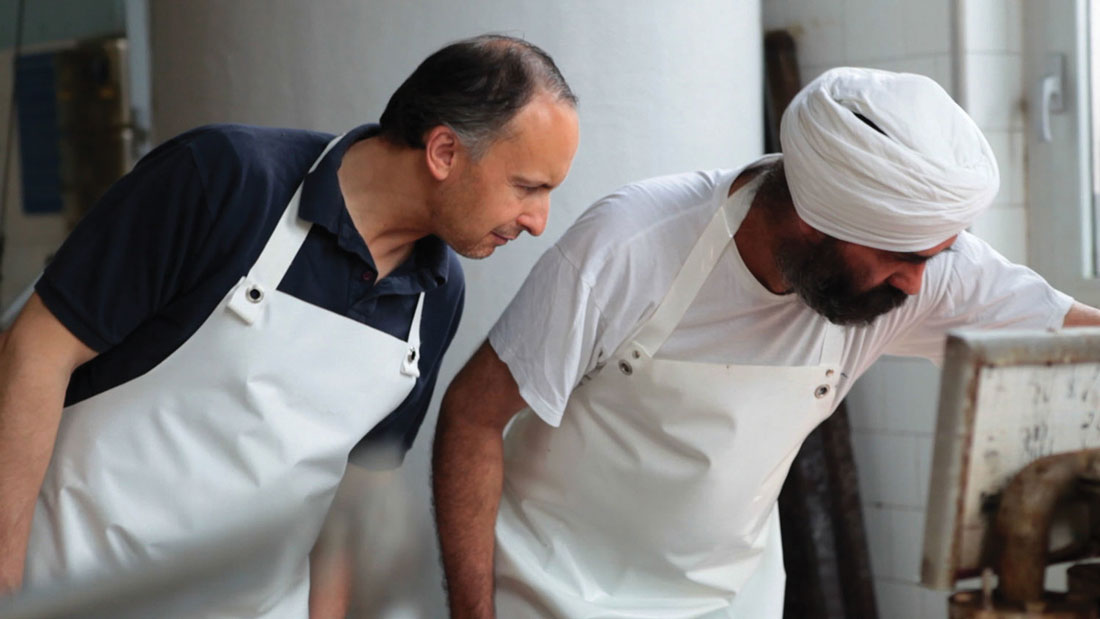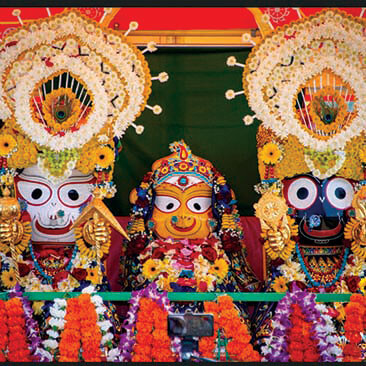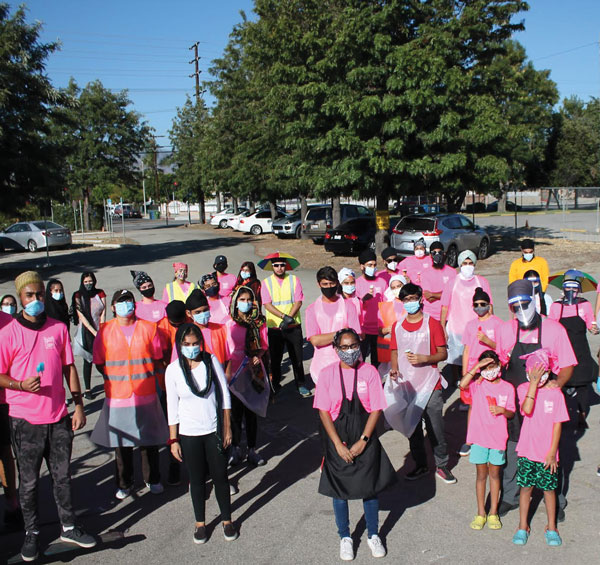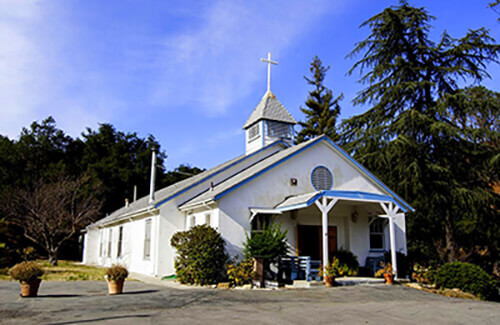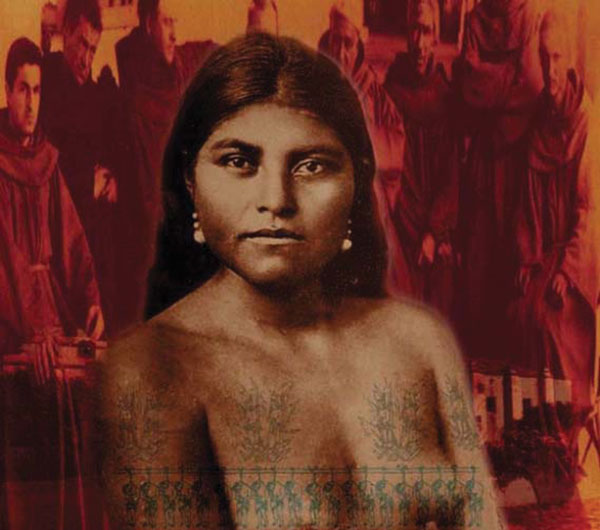Indian Sikhs Save ItalyŌĆÖs Parmesan Cheese Industry | |
Indian Sikhs Save ItalyŌĆÖs Parmesan Cheese IndustryWhy Parmigiano Reggiano still lands on your dinner plate.
From pasta to pizza, from fine cuisine to comfort food, the mention of Italian food sparks the imagination and excites the palate with combinations of fresh ingredients, seasonings unique to the country and artisanal cheeses. Three of the top ten best restaurants in Los Angeles rated by OpenTable.com, serve Italian cuisine.
Barely thirty years ago, the future of the parmesan cheese industry in Italy looked grim, as the younger generation left the family farms that make up the Italian cheese-making landscape. Without them, Los AngelesŌĆÖ Italian restaurants and grocery stores would have lost one of the key ingredients that provide the authentic savory flavors to Italian cuisine.
An unlikely, fortuitous turn of events forever transformed and ensured the future of Italian Parmesan cheese, when a group of brown-skinned, turbaned Sikhs from IndiaŌĆÖs Punjab province appeared in Northern ItalyŌĆÖs green valleys seeking work. They brought with them a love of farming and the innate skills that were in short supply in Italy and became the key to the renaissance of ItalyŌĆÖs Parmesan cheese.
Parmigiano Reggiano (what is commonly called Parmesan in the U.S.), is a hard, granular cheese produced from cowsŌĆÖ milk. It has a sharp, nutty taste, and is regarded by connoisseurs as the ŌĆ£king of cheeses.ŌĆØ Native to Northern Italy, its origins date back to the Middle Ages when monks began making hard cheese as a way of preserving milk.
By the Renaissance, it had become a staple meal that was used in snacks, soups, pasta, and main dishes. Cows are typically milked early in the morning and the milk is mixed with naturally skimmed milk, which is made by storing milk from the prior eveningŌĆÖs milking in large tanks to allow the cream to separate. This is just the beginning of a long and careful process in which milk is slowly heated in copper vats, curdled, separated, and aged for 12-36 months. More than 120 gallons of milk go into the production of a one-hundred-pound wheel that is only released for the market after inspection by an official governing body.
How Sikhs came to be involved in this ancient Italian tradition was revealed in a 2011 article in the Hindustan Times of New Delhi, titled ŌĆ£Sikh Stamp on Italian Cheese,ŌĆØ by the internationally renowned author Khushwant Singh after he visited several Sikh families in the Cremona region of Italy. He wrote, ŌĆ£It is the only patch of land where Italian is spoken in a Punjabi accent and cows understand only Punjabi.ŌĆØ Native to northern Italy, Parmigiano Reggiano dates back to the middle ages when monks made hard cheese as a way of preserving milk. Above, from the film Sikh Farmaggio, that explored todaysŌĆÖ bridging of two cultures. Photo Courtesy Dan Duran |
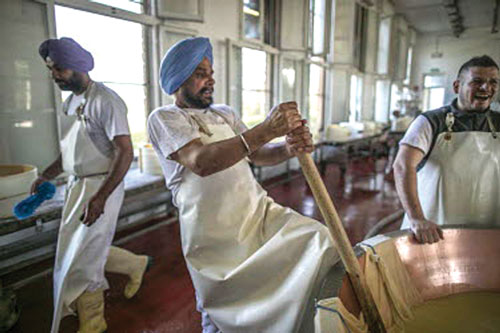 Sikh Migrant worker Singh Maha making Parmesan Reggiano cheese at the Roncocesi dairy factory, Photo Credit Catalina Martin-Chico, Courtesy of the BBc
The Punjab, ŌĆ£Land of Five Rivers,ŌĆØ is a large region spanning Northwest India and Northeast Pakistan. Regarded as the ŌĆ£breadbasket of India,ŌĆØ it is a largely agricultural state, and acres of lush farmland dot the countryside. The history of the Sikh community is intimately connected with the blessings of their fertile homeland. Extremely hard-working and entrepreneurial, they are the driving force in PunjabŌĆÖs agricultural industry and are well respected for their tenacity and perseverance.
Inveterate explorers and adventurers, they have become pioneers in farming in many parts of the world, including CaliforniaŌĆÖs Yuba City and Central Valley, where one of them, Didar Singh Bains, is regarded as ŌĆ£CaliforniaŌĆÖs Peach KingŌĆØ and in Indio, where Harbhajan Singh Samra is known as the ŌĆ£Okra King.ŌĆØ
Italy is among the more recent nations to reap the economic benefits of the Sikh community. In a relatively short period, it has become home to EuropeŌĆÖs second largest Sikh population, after the United Kingdom. Estimates show that between 60,000 and 150,000 Sikhs live in Italy. Beginning in the 1980s, with a larger influx in the 1990s, many Sikhs immigrated to Italy with the hope of better employment prospects and found the Po Valley of Northern Italy to be similar to Punjab with its warm climate, lack of mountains, and abundant agricultural opportunities.
Adapting to the Po Valley was neither a large culture shock nor a lifestyle adjustment for the newly arrived Sikh immigrants. They had worked in farming back home, and they did not need to speak Italian in order to do the agricultural work. Most Sikhs became involved in working directly with the cows, while others became cheese-makers. Their contributions were featured in 2011 in the New York Times, ŌĆ£In Italian Heartland, Indians Keep the Cheese Coming,ŌĆØ where Jaswinder Dubra, a Sikh who had risen over a period of 25 years from working as a dairy hand to working for one of ItalyŌĆÖs best known cheese manufacturers said, ŌĆ£This is dairy land and many of us have cows in Punjab. We are used to the work that we do here.ŌĆØ
Dalido Malaggi, Mayor of Cremona, commented in a documentary, Sikh Formaggio, that ŌĆ£Production of cheese in the region would have had many problems, since our youth population was not willing to work in farming. The presence of the Sikhs has allowed Italians to fill the work force gap and save parmesan cheese. While the dairy industry is mostly mechanized today, human labor is still necessary 365 days a year.ŌĆØ A Sikh farmer in the documentary commented, ŌĆ£The first shift usually begins at 4 a.m. and ends at 8 a.m., while the second shift is from 2:30 p.m. to 6:30 p.m.ŌĆØ  | 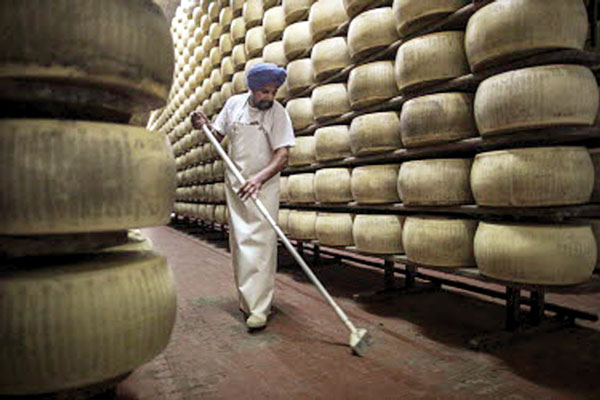 Sikh Migrant worker (who became an Italian citizen in 2013) Singh Mahan sweeps flow in a room where wheels of Parmesan Reggiano cheese are storied as they mature at the Ronococesi dairy factor Photo credit: Catalina Martin-Chico, Courtesy of the BBC The Italian peopleŌĆÖs gratitude for the SikhsŌĆÖ hard work and their attempts to help them integrate has been pivotal to the continued success of ItalyŌĆÖs export of Parmesan cheese. Alfredo Villa, a dairy farm owner mentions in ŌĆ£Sikh Stamp on Italian Cheese,ŌĆØ ŌĆ£I do not know what Sikhs tell my cows, but they behave very well. Sikhs are one of the most honest and hardworking people I have met in my life.ŌĆØ
In 2000, the Novellara municipality was the first in Italy to grant permission to build a Gurudwara, or Sikh temple, which over time, has become EuropeŌĆÖs second largest Gurudwara. Today, there are twenty-two Gurudwaras throughout Italy. Furthermore, Sikh families have embraced Italian culture, while also retaining their Punjabi heritage. In Sikh Formaggio, Jaspinder Saini states, ŌĆ£We eat Italian and Indian Punjabi food. You will see our pizza mixed up with onion and peppers. We mix everything.ŌĆØ Another resident, Bobby Harvinder said in a YouTube video, ŌĆ£Our whole life is here, including our childrenŌĆÖs schooling and hopefully their future careers. We are aware of our Sikh origins but we want our children to experience Indian and Italian culture as equally important.ŌĆØ
Sikh immigrants have a history of bringing their work ethic, instilled from centuries of working the land in Punjab, to remote corners of the globe. Their extroverted personality and willingness to shoulder hard physical labor with humor and without complaint have contributed to the growth of the Italian economy, while allowing Los AngelesŌĆÖ foodies to continue enjoying quality Italian cheese. The Government of Italy has ensured the continued bonanza of Parmesan by encouraging Punjabi cultural presence in local towns. Sikhs are now proud to call Italy their home. As a result, Angelinos will never have a shortage of authentic Italian Parmigiano Reggianogmail on our pasta and pizza.  | | | | | | | | | | | | | |
|
|
|
|
|




